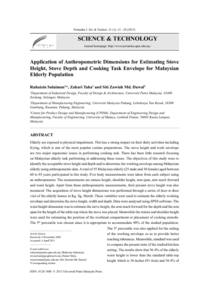Citation
Sulaiman, Ruhaizin and Taha, Zahari and Md. Dawal, Siti Zawiah
(2013)
Application of anthropometric dimensions for estimating stove height, stove depth and cooking task envelope for Malaysian elderly population.
Pertanika Journal of Science & Technology, 21 (1).
pp. 15-28.
ISSN 0128-7680; ESSN: 2231-8526
Abstract
Elderly are exposed to physical impairment. This has a strong impact on their daily activities including frying, which is one of the most popular cuisine preparations. The stove height and work envelope are two major ergonomic issues in performing cooking task. There has been little research focusing on Malaysian elderly task performing in addressing these issues. The objectives of this study were to identify the acceptable stove height and depth and to determine the working envelope among Malaysian elderly using anthropometric data. A total of 55 Malaysian elderly (25 male and 30 female) aged between 60 to 85 years participated in this study. Five body measurements were taken from each subject using an anthropometer. The measurements are stature height, shoulder height, arm span, arm reach forward and waist height. Apart from these anthropometric measurements, their present stove height was also measured. The acquisition of stove height dimensions was performed through a series of door to door visit of the elderly homes in Kg. Sg. Merab. These variables were used to estimate the elderly working envelope and determine the stove height, width and depth. Data were analysed using SPSS software. The waist height dimension was to estimate the stove height, the arm reach forward for the depth and the arm span for the length of the table-top where the stove was placed. Meanwhile the stature and shoulder height were used for estimating the position of the overhead compartment or placement of cooking utensils. The 5th percentile was chosen since it is appropriate to accommodate 90% of the studied population. The 5th percentile was also applied for the setting of the working envelope so as to provide better reaching tolerances. Meanwhile, standard was used to compare the present state of the studied kitchen setting. The results show that 56.4% of the elderly waist height is lower than the standard table-top height which is 36 inches (91.4cm) and 36.4% of the stove height was found higher than that of the standard. This could apparently cause fatigue and discomfort to shoulders, the neck, the arm and the back of the user. Anthropometrics measurements can be used for estimating the stove height, length and depth. These could also calculate a space taken for certain physical activities, such as frying task envelope. Providing a good combination of stove height, length, depth and ergonomic working envelope could hopefully improve the elderly cooking task and increase their quality of life.
Download File
![[img]](http://psasir.upm.edu.my/40485/1.hassmallThumbnailVersion/27.%20Application%20of%20Anthropometric%20Dimensions%20for%20Estimating%20Stove.pdf)  Preview |
|
PDF
27. Application of Anthropometric Dimensions for Estimating Stove.pdf
Download (1MB)
| Preview
|
|
Additional Metadata
Actions (login required)
 |
View Item |

